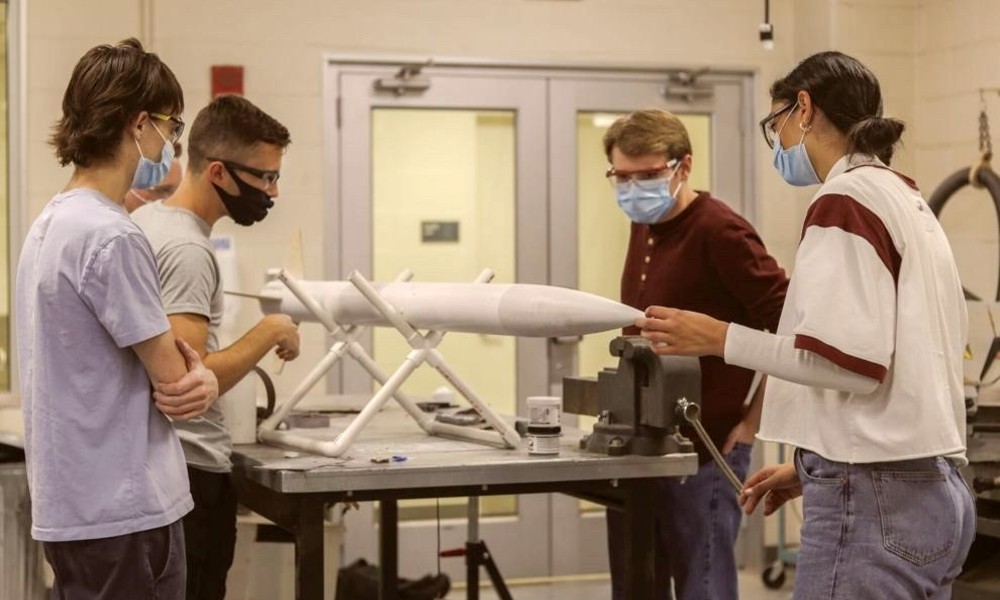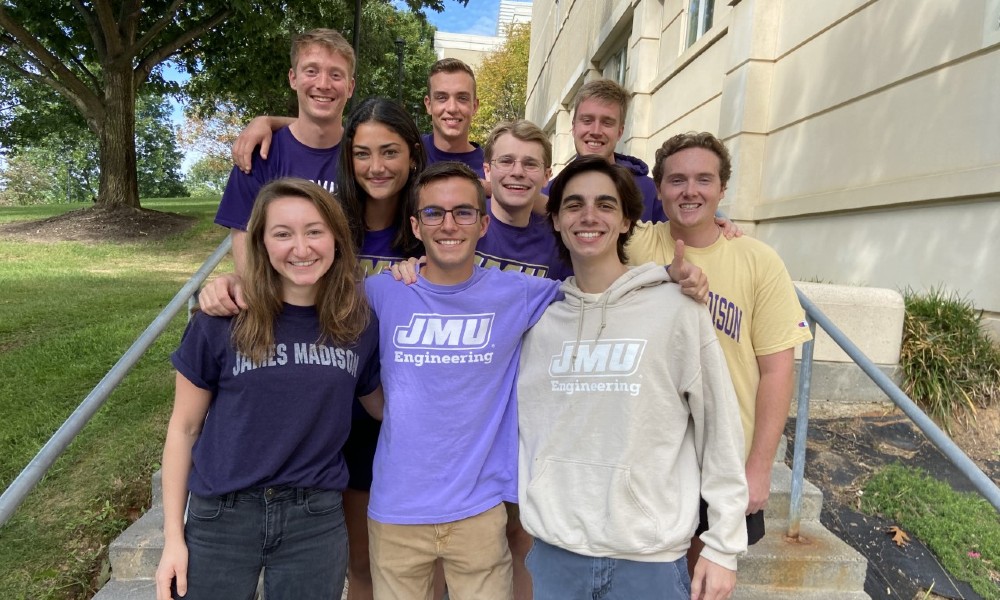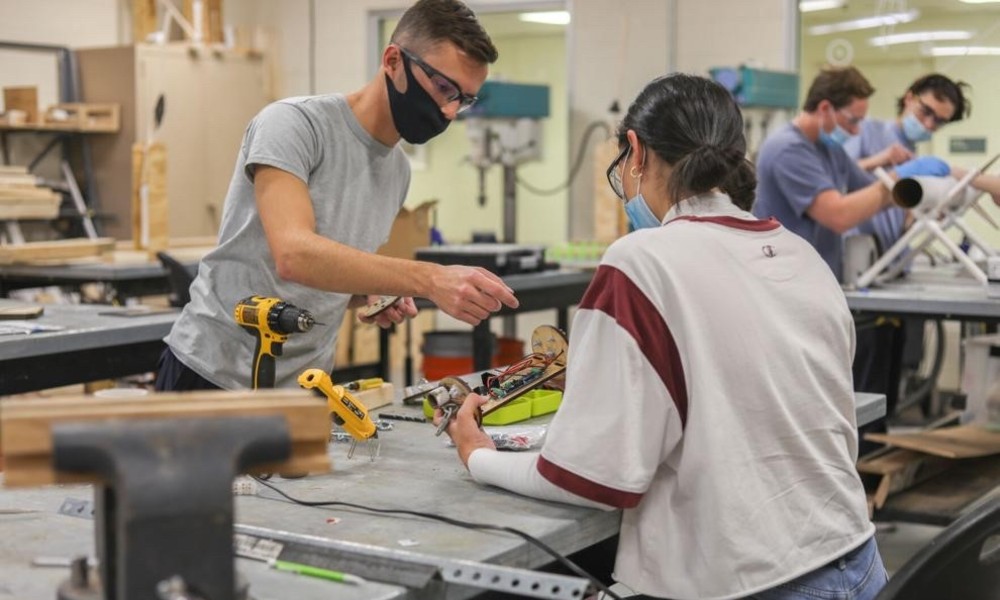Engineering students gear up to compete in NASA rocket launch
News
SUMMARY: Nine senior engineering students have joined together to work on a capstone project and will compete in NASA’s student launch initiative competition held in April, 2022.
By: Meghan Long, CISE student writer
For nine JMU senior engineering students, it actually is rocket science.
Abigail Maltese, Ben Hoare, Brandon Carroll, Cameron Funk, Coleson Baughan, Gray Roisch, Kelly Sadel, Kris Krueger, and Trace Scordo have joined together to work on a capstone project and will compete in NASA’s student launch initiative competition held in April 2022. They are one of 60 teams traveling to Huntsville, Alabama, to participate in the annual competition.
Brandon Carroll, the team’s project manager, helped get the project off the ground last year, proposing the idea as a potential capstone project to other members of the rocketry team.

“We knew we were interested in doing a project related to aerospace, so we started investigating collegiate rocketry competitions. This one grabbed our attention because you have the opportunity to work with NASA throughout the duration of the project,” Carroll explains.
Sadel is the point of contact and team manager. She filters through all communications from NASA and deals with team-related tasks like scheduling and administrative work. “We are the inaugural aerospace team for JMU Engineering,” Kelly explains. “A lot of the other teams involved in this competition have had teams before them to learn from and work with. We have done a lot of learning from the ground up.”
Carroll and Sadel meet with their team three times a week for a minimum of two hours and have been able to thrive despite starting the project during COVID. They only met twice as an entire group last year, but have worked tirelessly to learn the necessary skills to make their project one they can be proud of. “We have many deadlines we have to meet almost every month,” Carroll says. “People are staying from 8:00 in the morning until 8:00 at night working on this project.”
The project is no small feat. The team is designing, testing, fabricating, and ultimately launching a high-powered rocket in a competition against participating universities.

Apart from the challenge, the terms of the competition require the teams to engage a minimum of 250 students in STEM activities. JMU is meeting this requirement by partnering with the Expanding Your Horizons event, hosting trivia nights, and creating a rocketry-related assignment for a first-year engineering design course. The rigor of this competition is not lost on the team. “Since this is a government-sponsored competition, they are expecting government-level work,” Carroll stresses.
The students who make up the team are an impressive cohort of future engineers. Two of the team members acquired National Association of Rocketry High Power Rocketry (NAR HPR) certifications with guidance from Valley Aerospace Team (VAST) mentors. They did this by creating successful individual designs, builds, and launches of high-power rockets. Carroll explains, “Essentially, they have done half of our project individually at a smaller scale. They have helped out our team so much.”
Carroll and his team members have started a legacy that will open the door for many engineering students to come. Abigail Maltese, head of STEM engagement, explains what the team’s groundbreaking work means to them. “Opening the door for more students to get involved in aerospace at JMU is extremely special to us. We are leaving this amazing opportunity for all of the students that will come after us,” she says. A second student team comprised of junior engineering students has already been assembled and will pursue participation in the 2023 competition.
Jacquelyn Nagel, assistant department head of engineering and professor, serves as the team's capstone project course instructor and adult educator. “This project shows that when students have initiative and act upon it, they can shape what they learn. Our engineering program supports student agency and ownership in learning, and this exemplifies that,” she says.
“The students are doing much more than just building and flying rockets,” says Keith Holland, associate vice provost for research and innovation, who also serves as the team’s capstone project advisor and adult educator. “The team has had an abundance of professional experience—developing proposals and giving several presentations to NASA to share and receive feedback on their rocket and payload design.” Holland explains how he looks forward to his weekly meetings with the team. “They collaborate well together and always go the extra mile. They want to represent JMU well.”
The Rocketry Team hopes the community will continue supporting their project that puts the JMU Engineering program on the map. “Rockets are expensive,” Sadel explains. “Our goal is to raise $10,000 this year so we can cover all of our parts, assembly, and travel to the competition.” Anyone interested in supporting the team can visit their website to donate.
The Rocketry Team has gained a significant following beyond the JMU community on social media platforms. The team regularly shares their progress with followers—and plans to continue to do so leading up to the launch. To follow along with their progress, look out for updates on their Instagram and TikTok: @jmurocketry.
“The engineering program is special because it is student-based, and you get to form the path that you want,” Maltese explains. Sadel adds, “We are all so excited about this project. A lot of hard work has gone into this, and we are looking forward to April’s launch.”
